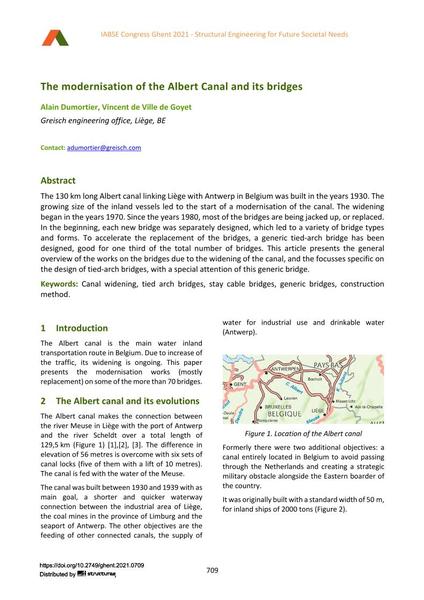The modernisation of the Albert Canal and its bridges

|
|
|||||||||||
Détails bibliographiques
| Auteur(s): |
Alain Dumortier
(Greisch engineering office, Liège, BE)
Vincent de Ville de Goyet (Greisch engineering office, Liège, BE) |
||||
|---|---|---|---|---|---|
| Médium: | papier de conférence | ||||
| Langue(s): | anglais | ||||
| Conférence: | IABSE Congress: Structural Engineering for Future Societal Needs, Ghent, Belgium, 22-24 September 2021 | ||||
| Publié dans: | IABSE Congress Ghent 2021 | ||||
|
|||||
| Page(s): | 709-717 | ||||
| Nombre total de pages (du PDF): | 9 | ||||
| DOI: | 10.2749/ghent.2021.0709 | ||||
| Abstrait: |
The 130 km long Albert canal linking Liège with Antwerp in Belgium was built in the years 1930. The growing size of the inland vessels led to the start of a modernisation of the canal. The widening began in the years 1970. Since the years 1980, most of the bridges are being jacked up, or replaced. In the beginning, each new bridge was separately designed, which led to a variety of bridge types and forms. To accelerate the replacement of the bridges, a generic tied-arch bridge has been designed, good for one third of the total number of bridges. This article presents the general overview of the works on the bridges due to the widening of the canal, and the focusses specific on the design of tied-arch bridges, with a special attention of this generic bridge. |
||||
| Mots-clé: |
ponts bow-string
|
||||
| Copyright: | © 2021 International Association for Bridge and Structural Engineering (IABSE) | ||||
| License: | Cette oeuvre ne peut être utilisée sans la permission de l'auteur ou détenteur des droits. |
||||
